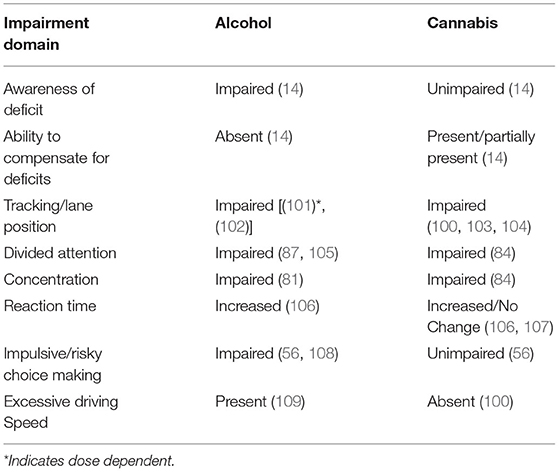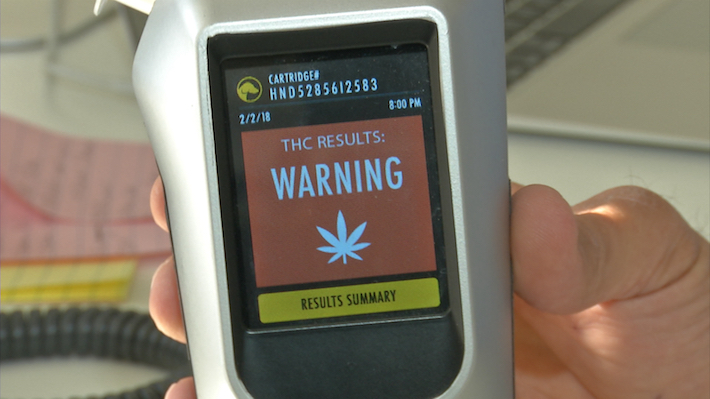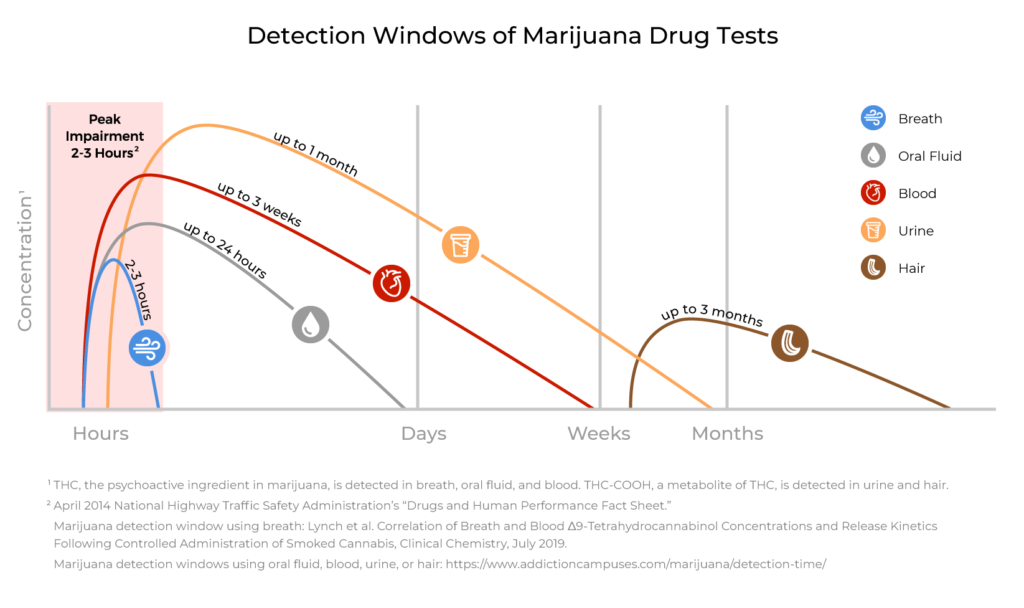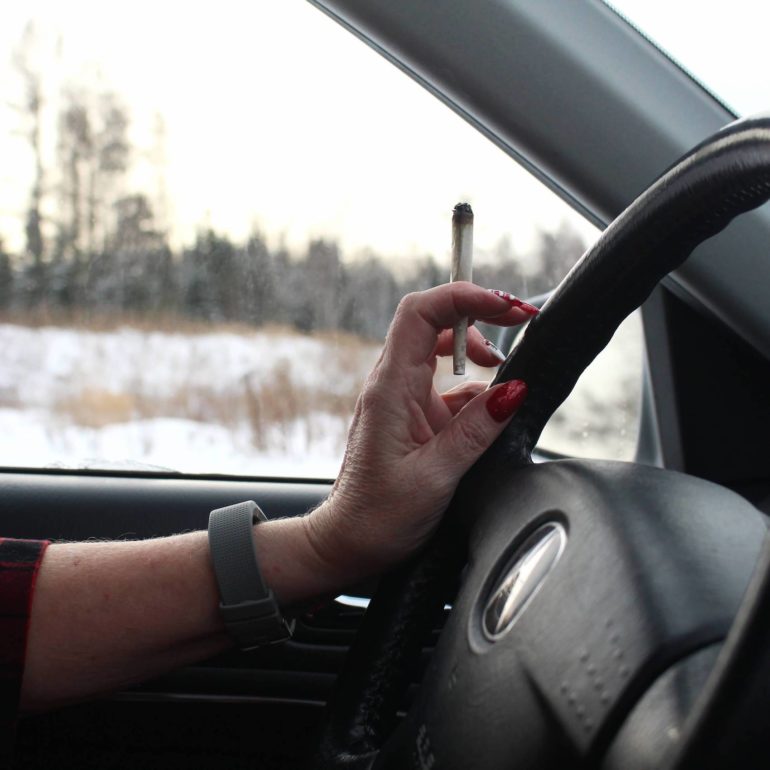Our recent survey revealed that while 49% of people who’ve used cannabis in the US wouldn’t drive drunk, they do drive high. If you’ve been high before, this is kind of understandable – especially for regular smokers, if you’re a little high, you feel “in control” enough to drive safely. But there are many obvious arguments against this. Even though you might not feel as though you’re as dangerous on the road as if you were drunk, you’re still definitely impaired and are likely putting yourself and others at unnecessary risk. The fact that half of all weed users are happy to do this is concerning, to say the least, especially when you consider the rise in car crashes that accompanies cannabis legalization.
But what does the evidence say about high driving? Is it really as bad – or as innocuous – as we might assume? How should states test for marijuana impairment? We’ve taken a detailed look at the issues and the surrounding evidence to find out.
Key Findings: Is Driving High Dangerous?
- Drunk-driving always spikes around the holidays, and people tend to have a more relaxed attitude to driving while high.
- Studies comparing states show that those with legal weed, such as California, Colorado, Nevada, Oregon and Washington, see an increase in road accidents.
- High people aren’t as good at staying in their lane, concentrating, dividing their attention or reacting quickly, all essential skills for driving.
- The risk of accidents increases by 36% for high drivers (compared to sober ones), but for drunk drivers it increases by 20 times (i.e. 2000%).
- Combining both weed and alcohol may be worse than the sum of the individual effects of both.
- The risk of accidents roughly doubles for people using prescription opioids and increases by around 70% for benzodiazepines, making both more risky than cannabis for driving.
- Current methods to test for cannabis impairment aren’t specific or reliable enough: regular users will basically always test positive.
- This impacts the evidence on the whole, and also makes it hard for states to enforce legal limits for pot.
- If you wait three to four hours after smoking, you’re basically sober enough to drive again. Otherwise you shouldn’t drive high, especially if you’ve also had a drink.
Drunk Driving Around the Holidays: More Common Than You’d Think

December is National Impaired Driving Prevention Month, and there’s a simple reason for this: drunk driving spikes around the holidays and the period from Thanksgiving to New Year has some of the biggest. For example, a Texas-focused analysis found that on New Years, crashes increase by 95%, fatalities by 55% and injuries by 59%, relative to non-holiday days either side of the holiday. For Christmas, crashes increase 20%, fatalities by 56% and injuries by 27%.
This is essentially because people drink more around the holidays, and so drunk-driving increases around the same time. Other statistics suggest that 42% of all car accidents on New Years’ Eve involve a drunk driver, and that around 28% of all deaths in traffic accidents in December are related to alcohol. People drink more, so people drink-drive more, and more people die as a result.
Drunk Driving vs. High Driving: Differing Attitudes

While most people accept that drunk driving is an issue – and for example, only 24% of people in the survey said they drive after drinking – attitudes to weed are very different. In our survey, 64% said they feel safer driving high than they do driving drunk, and, as mentioned in the introduction, almost half said they do it. A quote from a cannabis consumer who spoke to The Bluntness sums up this difference in attitude quite well:
If you’re drunk, you drive to a stop sign and blow through it. If you’re high, you get to a stop sign and wait for it to turn green!
This is obviously intended as a joke, but really it strikes on a key part of the difference in attitudes. The stereotype of a drunk is someone reckless, with poor motor skills and little consideration for that fact, while the stereotype of someone stoned is being impaired but in a kind of comically-inept way that is unlikely to hurt anyone. And from experience people will undoubtedly know that you’re extra-careful if anything when driving high. These factors really combine to produce this stereotype of stoned drivers being impaired but still kind of harmless.
Is it Dangerous to Drive High? Sources of Evidence

However, the stereotype doesn’t necessarily live up to reality. The key question underlying this whole debate is: is it dangerous to drive high? While other sources are also valuable, a recent review from Pearlson et. al. gives a thorough run-down of the most important evidence and the caveats we need to keep in mind.
Increases in Crashes in Legal States
There are a few different ways to look at this problem, and we’ve already mentioned the simplest in the introduction. What happens to accident rates when a state legalizes cannabis? In Colorado, for example, the proportion of drivers in fatal accidents who tested positive for cannabis increased from 5.9%, prior to the commercialization of cannabis (defined as mid-2009), to 10% by the end of 2011. In Washington, the percentage testing positive for THC increased from 19.1% in 2009 to 2012, to 24.9% after the legalization of cannabis. Additionally, the source mentioned in the introduction (research from the Insurance Institute for Highway Safety) looked at California, Colorado, Nevada, Oregon and Washington and found that the rate of crashes resulting in injuries increased by 6%, relative to non-legal states.
However, this is a little hard to interpret definitively. One important point (that we’ll expand on later) is that testing positive for cannabis does not equal impairment, but it’s also clear that an increase in accidents in legal states doesn’t necessarily mean weed is to blame. It’s likely, admittedly, but not definitive. Plus, even though weed is legalized at a specific time, use and availability could have increased before this time.
Impairment for Specific Driving Tasks
The paper from Pearlson et. al. points out that one way to break down this issue is to look at the impact of smoking cannabis on specific driving tasks, such as reaction time or staying in your lane. These studies generally show that there is some impairment as a result of using cannabis, but not in all areas. The main areas of impairment (taken from several studies – see the full paper for more information) are as follows:
- Position tracking/lane position
- Divided attention
- Concentration
- Reaction time (sometimes no change)

However, drivers under the influence of cannabis didn’t make impulsive or risky decisions, didn’t drive excessively quickly, were generally aware of their impairment and some were able to compensate for it.
Direct Evidence on Cannabis Use and Crash Risk
A 2016 meta-analysis from Rogeberg and Elvik used data from across several studies (and around 240,000 participants) to investigate the risk of being involved in or responsible for a crash after consuming cannabis. The result showed that there is a significant increase in risk after consuming cannabis, but not a huge increase. Specifically, the odds ratio from all of these studies combined came out to 1.36, meaning that the risk is 36% higher than that for a sober driver. There are also other estimates, with one example coming out to an odds ratio of 2.3, meaning a 230% increase in risk (i.e. slightly more than double).
So is it Dangerous to Drive High?
So overall, there is evidence from a few different places that suggests an increase in risk if you drive high. Broader-level patterns suggest that cannabis becoming widely available leads to more accidents, experimental studies find that specific driving-related tasks are impaired and the best-quality evidence out there shows a moderate increase in risk. In short, it’s hard to avoid the conclusion that driving high is more dangerous than driving sober.
Driving High vs. Driving Drunk – Which is More Dangerous?

Although you’re a more dangerous driver if you’re high, the evidence shows that drunk drivers are more dangerous. In addition to the specific impairments listed above for people who’ve consumed cannabis, drunk drivers are unaware of their deficit, cannot compensate for it, make riskier choices and drive excessively quickly.
The authors of the meta-analysis mentioned in the previous section also estimated the increase in risk from having a blood alcohol content of 0.10%. Using sober drivers as a baseline, drunk drivers have an odds ratio of roughly 20, compared to 1.36 for high drivers. In other words, if you’re stoned, your risk increases by 36%, but if you’re drunk the risk increases by 2000%. The other meta-analysis also mentioned put the cannabis odds ratio at 2.3 but the one for alcohol at 9.4.
So while this doesn’t excuse driving high by a long stretch, the evidence is fairly strongly in favor of driving high being safer than driving drunk.
Does Driving High and Drunk Increase the Risk Even More?
One of the main areas of concern and uncertainty is whether there is a synergistic effect of alcohol and cannabis together. In other words: does being both drunk and high increase risks beyond just the sum total of the individual effects? This is a particularly serious issue because the number of people involved in crashes with both substances in their systems increased from 2% in 1991 to 10% in 2008, and is likely still increasing.
The second meta-analysis discussed above put the odds ratio for cannabis at 2.3 and alcohol at 9.4, but the combined one at 14.1, which is more than just the sum of the two ratios. Additionally, the authors of the study that found increased accidents resulting in injuries in legal states speculated that the combined effect of alcohol and cannabis was more likely to be the explanation than cannabis alone.
This all said, the Pearlson et. al. review addressed this issue in detail and essentially concluded that there isn’t sufficient evidence to form a strong conclusion at this point. There are many studies that suggest an effect beyond the sum of the parts, but there are also several that suggest a purely additive effect. Additionally, they point out that only a very limited range of doses have been investigated so far, and this is an important issue currently holding back research into the area.
Do Prescription Medications Impair Driving?

Although prescription drugs are given to you by a doctor, many of them can have obvious and not-so-obvious impacts on your driving, too. This is a slightly difficult issue to address, because it’s hard to separate the effect of the illness you’re treating and the medication itself, but there are studies on the topic to look at.
There are many classes of medication that could have an effect on driving ability, but two good examples are opioids and benzodiazepines. One meta-analysis on opioids looked at 10 studies that focused on crash involvement and 5 on culpability for the crash. When all the data were pooled together, the researchers found that people taking prescription opioids were 2.3 times (i.e. 230%) more likely to be involved in an accident and 47% more likely to be culpable, compared to people not using opioids.
For benzodiazepines, the evidence (from two meta analyses) suggest that users of them have a 60 to 80% greater risk of being involved in an accident, and a 41% increase in the risk of being culpable. The authors of the study also note that the risk increases 7.7-fold if benzos are used in combination with alcohol.
Although going into everything in detail is implausible here, a review article from 2014 covers many classes of medication and finds potential risk increases with: barbiturates, non-benzodiazepine hypnotics (e.g. Zolpidem), tricyclic antidepressants, non-steroidal anti-inflammatory drugs (although this is possibly linked to co-prescribed pain medications), anti-epileptic drugs (although the reduction in seizure risk balances this), second-generation antipsychotics and hypoglycemic agents.
In short, commonly-prescribed medications carry a broadly similar risk of increasing accidents as cannabis, using the highest estimate of the risk from cannabis. If we take the more conservative but well-established estimate of a 36% increase in risk for weed, both opioids and benzodiazepines are worse.
Do High Drivers Compensate for Their Impairment?
As mentioned above, cannabis users are generally more aware of their intoxication than people drinking alcohol. This means that they may drive more carefully as a result, and indeed the evidence suggests that they either can do so or at least partially make up for it. The Pearlson et. al. review comments that:
“One major behavioral difference that we observe in our subjects is that cannabis-intoxicated volunteers report not only being aware of their likely driving impairment, but also overestimate its degree, and consequently tend to drive more slowly in an attempt to compensate for deficits.”
This is kind of in line with the joke-y user comment from earlier about high drivers “waiting for the stop sign to turn green” rather than running through it. In some cases, the over-cautious behavior is likely to be a bigger sign of driving high than reckless driving. Driving slowly isn’t always safe – in some cases it can create its own risks – but this is likely a big part of the reason driving high doesn’t seem to be as bad as driving drunk.
Is the Evidence on Cannabis Use and Driving Reliable?
Although the overall conclusions regarding driving high are hard to dispute – you are a worse driver when high, unavoidably – there are many issues that need to be kept in mind. The most important by far is the issue of “impairment” vs. “having detectable amounts of THC in your bloodstream.” If you’ve ever looked into the amount of time weed is detectable in your blood, urine or even saliva after using, you’ll have likely been dismayed to find that it sticks around for a long time.
In blood, it can be detected for around a day and sometimes up to 36 hours, in urine it can be detected for a month or even more and even in saliva it’s detectable for over a day. These are impacted by how much you use – so a single joint won’t stick around for this long if it’s your first time – but for regular users it will basically always be detectable for over a day, at the very least. This is essentially because THC is stored in fat cells and organs, so it tends to be excreted over a much longer period than most drugs. For example, cocaine will be gone from everything but your hair after four days.
This leads to a big problem: having THC in your system doesn’t suggest that you’re currently impaired at all. If I smoke a joint today and go out on the road tomorrow or even the day after, chances are I’ll test positive. But it’s absurd to suggest that I’ll still be high. And so if I was included in one of the studies discussed above, I would be classed as a “high driver” in an accident, but I would actually be a sober driver in an accident. This is a huge issue. Essentially, in the absence of a roadside impairment test or an outright confession, it’s very difficult to determine if someone involved in an accident is currently high.
Another issue with many of the studies in a non-experimental setting is that they often focus on the presence of THC but don’t consider alcohol. This makes interpreting the evidence more difficult because it could be either drinking or smoking to blame, or a combination of both.
However, it’s important to stress again that while some studies have issues, there are multiple lines of evidence that suggest that driving high is more dangerous than driving sober. Experimental-style studies conducted on simulated driving systems, for instance, are basically immune to these criticisms and still show clear impairment.
Is There a Way to Test for Weed on the Roadside?

The “breathalyzer” test for alcohol really produces high expectations for how well police can determine if someone is under the influence. Cannabis isn’t detectable in the breath in the same way, so other approaches need to be used. Although many states simply say any THC in the blood of a driver is illegal, it seems more reasonable to impose a “per se” law, which basically sets a limit for blood THC in the same way as is done for alcohol. If you’re caught with more than this in your blood, you’re considered impaired under the law.
The most common level for this is 5 ng/ml of blood. This was the approach used by Colorado, for example, but it had to be changed after some drivers won a court case against the strict limit. This is basically for the same reasons as discussed above: cannabis can stay in your system for a long time, so even being over this threshold isn’t a reliable indicator that you’re impaired. In Colorado now, police must show impairment in order to prosecute anyone for driving high.

There is also a potentially more concerning issue: if you are high, there is a good chance that your blood won’t register a problem based on these laws. The amounts of THC in your blood are simply not reliable enough to call it in either case.
Saliva tests are a little better, but still ultimately suffer from the same issues as other methods. Really, police need the equivalent of a breathalyzer for cannabis, but at present, while one candidate looks promising, there is nothing that works reliably. A report from the Congressional Research Service concluded:
“Thus, some researchers, and the National Highway Traffic Safety Administration, have observed that using a measure of THC as evidence of a driver’s impairment is not supported by scientific evidence to date.”
Is it Morally Wrong to Drive High?
So with all of the evidence in mind, and the issues police are likely to have with determining that you’re impaired: is it really that bad to drive high? Are the 49% of people in our survey who’d high-drive but would never drink-drive actually right?
We would argue that they are still not right. We’re not saying that driving high is as bad as driving drunk, nor that the methods cops use to determine if you’re over the limit are valid, but if you are actually high then you definitely shouldn’t drive. The moral issue of driving while intoxicated isn’t about a comparison to other substances or a finicky legal argument about what it really means to be “intoxicated.” You know when you’re high. The evidence shows that being high increases your risk of being in an accident. Morally, these are the only two relevant facts: if you drive, you’re risking your own and other people’s lives, likely for no reason.
You might try to correct by creeping around at a snail’s pace, but this brings its own risks and will likely get you pulled over if a cop sees you. If you drive at relatively normal speeds, you’ll be putting people at risk in a more direct way. Simply put, driving impaired – regardless of the substance – is dangerous and could easily get somebody killed. Getting an Uber is way less of a hardship than having that on your conscience.
In a nutshell: you should never drive high.
How Long are You Impaired for After Smoking Weed?
We’re strongly against high driving, but we aren’t stupid. Around 20 to 40 minutes after inhaling cannabis, you’re the most dangerous you’re going to be on the road throughout the entire high. Up to two and a half hours afterwards, you’re likely less high but still somewhat impaired. However, if you’ve waited three to four hours, you’re probably essentially fine.
One double-blind trial on the topic looked at lane-weaving, and participants were tested both 40 minutes and 240 minutes after inhalation. They vaped different types of cannabis: THC-heavy, CBD-heavy and strains with roughly equal amounts. While lane-weaving increased for cannabis users after 40 minutes (apart from with CBD-dominant cannabis), it was back to usual levels after 240 minutes (i.e. four hours).
Of course, the longer you can wait the better. But the evidence suggests that if you wait about four hours you won’t be meaningfully impaired anymore. So if you can stick around wherever you are for a bit, this is a good solution for getting home without a cab and without putting people at risk. That said, as covered above, the cops will probably not be as relaxed about it, so you’re still taking a risk in a legal sense.
Conclusion
High drivers aren’t as bad as drunk drivers, and they’ll probably drive slower and try to compensate, but they are still way riskier than sober drivers. Treating it slightly differently is ok, especially if you wait for a few hours or more before driving, but let’s not delude ourselves into thinking driving high is totally fine. Even if you would do it, chances are that deep down you already know it isn’t morally right. As more states legalize cannabis without a definite, workable plan for dealing with high driving, the onus is on us, as the consumers, to be sensible and save people’s lives. Especially over the holidays, we should take extra care to keep each other safe.
References
- Adams, M., n.d. Driving While High: Does Weed Really Improve Your Driving Skills?. [online] TheBluntness. Available at: https://www.thebluntness.com/posts/driving-while-high [Accessed 21 December 2021].
- Arkell, T., Vinckenbosch, F., Kevin, R., Theunissen, E., McGregor, I. and Ramaekers, J., 2020. Effect of Cannabidiol and Δ9-Tetrahydrocannabinol on Driving Performance. JAMA, 324(21), p.2177. https://doi.org/10.1001/jama.2020.21218
- Chihuri, S. and Li, G., 2017. Use of prescription opioids and motor vehicle crashes: A meta analysis. Accident Analysis & Prevention, 109, pp.123-131. https://doi.org/10.1016/j.aap.2017.10.004
- Dassanayake, T., Michie, P., Carter, G. and Jones, A., 2011. Effects of Benzodiazepines, Antidepressants and Opioids on Driving. Drug Safety, 34(2), pp.125-156. https://doi.org/10.2165/11539050-000000000-00000
- Hetland, A. and Carr, D., 2014. Medications and Impaired Driving. Annals of Pharmacotherapy, 48(4), pp.494-506. https://doi.org/10.1177/1060028014520882
- Iii.org. 2021. Background on: Marijuana and impaired driving. [online] Available at: https://www.iii.org/article/background-on-marijuana-and-impaired-driving [Accessed 21 December 2021].
- Manus, K., 2020. New Years is One of the Most Dangerous Holidays of the Year. [online] Kwartler Manus, LLC. Available at: https://www.kminjurylawyers.com/firm-news/blog/2020/december/new-years-is-one-of-the-most-dangerous-holidays-/ [Accessed 21 December 2021].
- Pearlson, G., Stevens, M. and D’Souza, D., 2021. Cannabis and Driving. Frontiers in Psychiatry, 12. https://doi.org/10.3389/fpsyt.2021.689444
- Rogeberg, O. and Elvik, R., 2016. The effects of cannabis intoxication on motor vehicle collision revisited and revised. Addiction, 111(8), pp.1348-1359. https://doi.org/10.1111/add.13347
- Salomonsen-Sautel, S., Min, S., Sakai, J., Thurstone, C. and Hopfer, C., 2014. Trends in fatal motor vehicle crashes before and after marijuana commercialization in Colorado. Drug and Alcohol Dependence, 140, pp.137-144. https://doi.org/10.1016/j.drugalcdep.2014.04.008
- Stelmakowich, A., 2021. Mix of cannabis and alcohol possible driver of higher rates of vehicle crashes [online] Edmontonjournal.com. Available at: https://edmontonjournal.com/cannabis-news/mix-of-cannabis-and-alcohol-possible-driver-of-higher-rates-of-vehicle-crashes [Accessed 21 December 2021].
- Stout, H., 2017. Most Dangerous Holidays that Causes Drunk Driving Accidents in Texas. [online] Sutliff & Stout, Injury & Accident Law Firm. Available at: https://www.sutliffstout.com/research/holiday-drunk-driving-crashes-texas/ [Accessed 21 December 2021].
